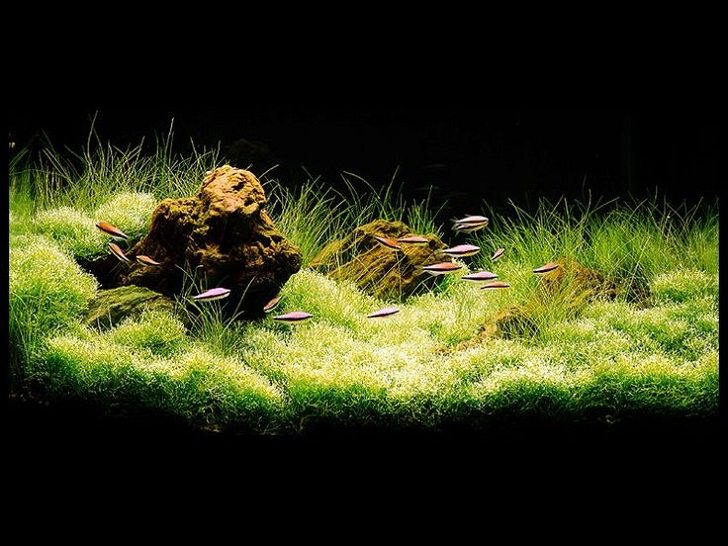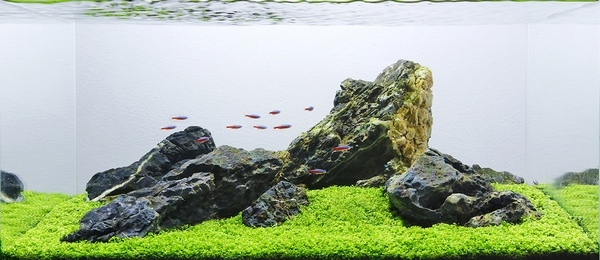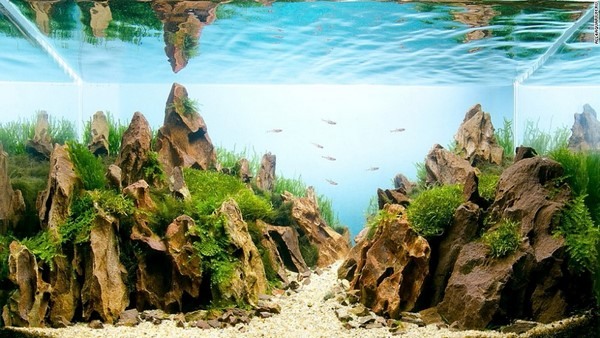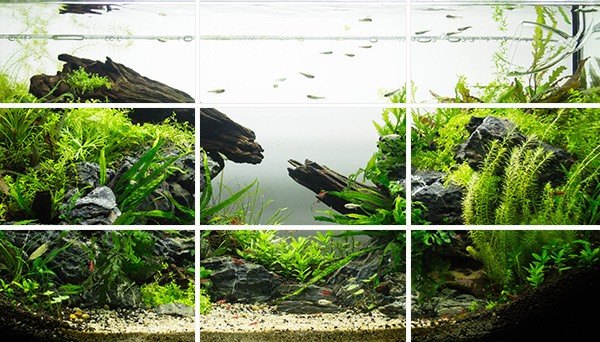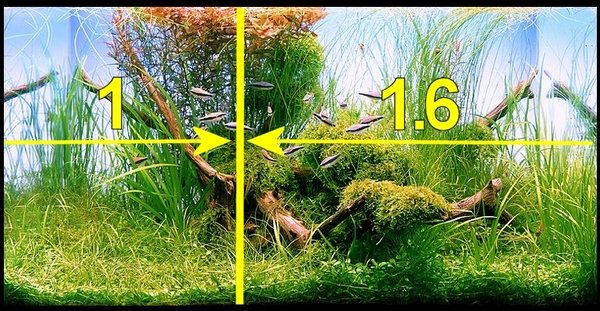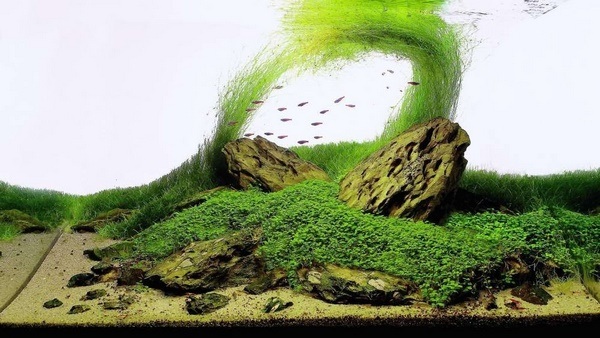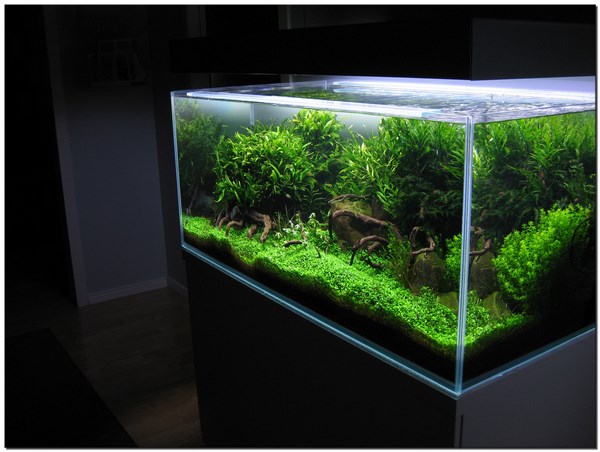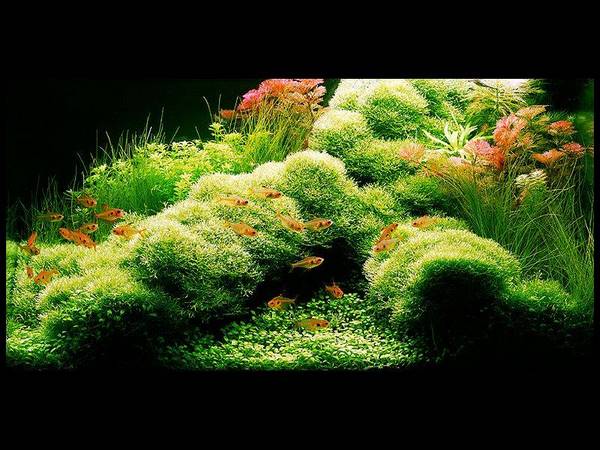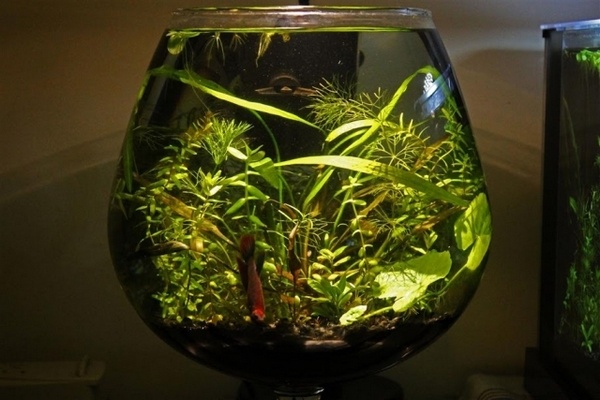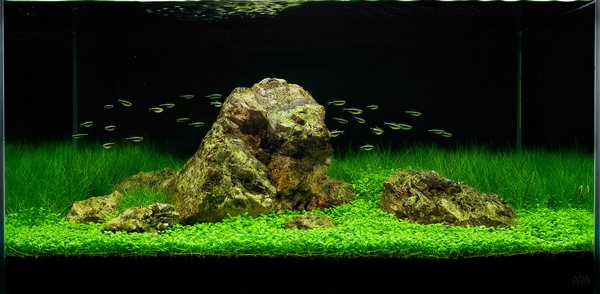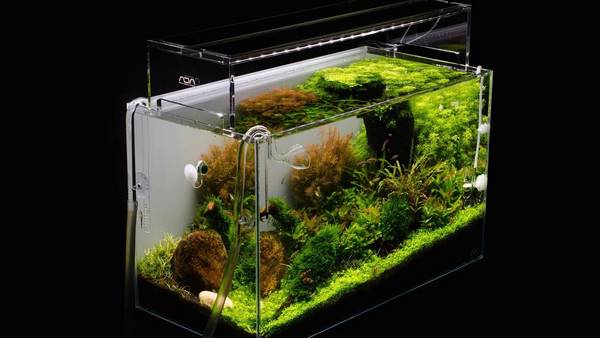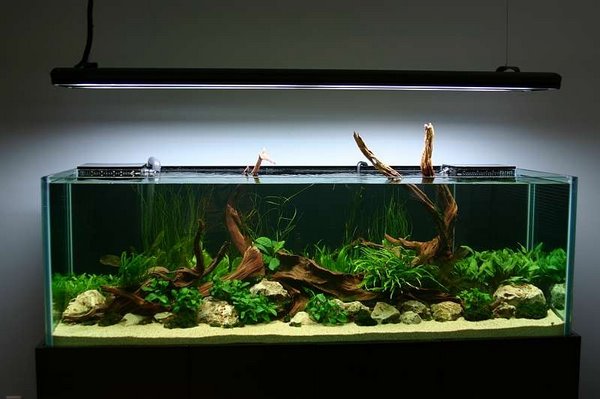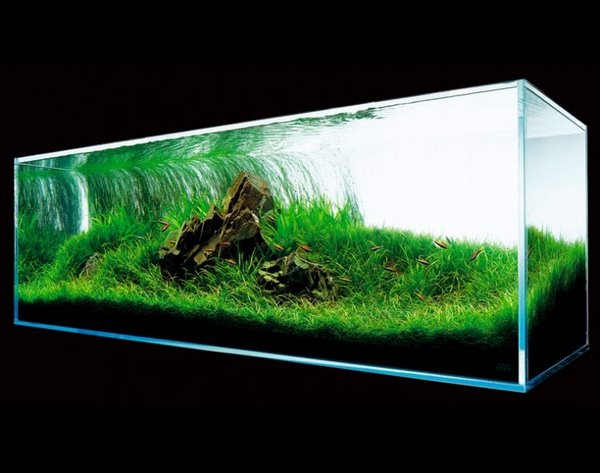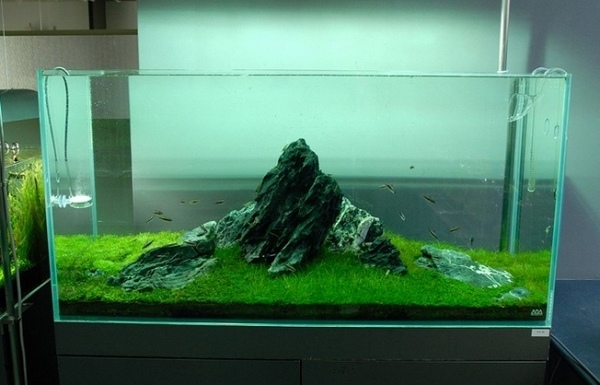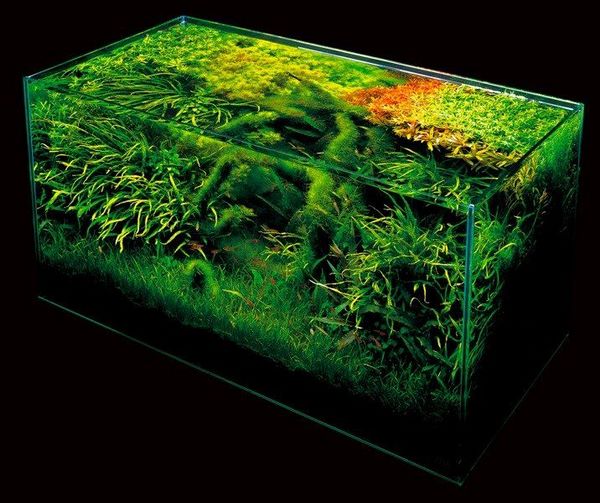What is aquascape? Aquascape (from “aqua” – water and “scape” – landscape) is the art of creating compositions or landscapes in an aquarium. This type of art has become more and more popular over the past few years. The most simple definition of the term describes it as “underwater gardening”, which includes techniques for the placement, layout and arrangement of a number of elements – aquatic plants, stones, wood, etc., in an aesthetically pleasing way.
Aquascaping originated in Japan and became popular due to the works of the landscape photographer and aquatic designer Takashi Amano. The concept carries a philosophy of existence, encourages meditation and fascinates the human eye. The idea of the design must come from the depths of the human soul and despite the fact that it is not easy to create the perfect aquascape, once you decide to begin this adventure this amazing art becomes an interesting, challenging and satisfying hobby.
What are the basic principles of aquascape?
The aquascape process may seem difficult but it is not as complicated as it may seem, as long as you keep and observe some simple principles. Finding the perfect balance between scientific principles and creativity is probably the most difficult task, but nothing is impossible when we talk about human’s imagination. Here are some of the main features that you need to consider before beginning your aquascape:
Simplicity – keep in mind that fewer items in the aquarium will look more beautiful. For example, one of the most common mistakes is that people are tempted to include as many plants as possible in order to achieve visual diversity and dynamics, but in most cases the result is exactly the opposite.
Diversity – Keeping the design simple does not mean to use just one plant as this will make the aquarium look quite boring. Find out what are the best plants for aquascaping, how they can be combined and work together harmoniously and always remember that your imagination plays a huge role.
Proportions – this is, probably, the most important feature as it gives your aquarium a harmonious look. This means that you need to create a balance between open and closed space, to choose the right plant species and other elements.
Consistency – Aquascaping can be tricky, time consuming and even tedious. You may have to break down some of the constructions and rebuild them if something in the design irritates your eye.
Symmetry and shape or to be exact – the lack of symmetry is another important feature. As you know, imperfections give individuality and character to landscape especially when your goal is to create a design resembling Nature.
Basic elements of aquascape and considerations to keep in mind
As we mentioned, in aquascape, imagination and creativity have as much importance as proportion, diversity and the application of scientific principles. Of course, just like in garden landscaping, aquascape is based on some basic elements – lighting, filters, carbon dioxide, hardscape materials, etc.
The first element of aquascaping is the container (aquarium) and its size and depth should be carefully considered. The particular idea for the aquascape design will determine the size of the aquarium. Experts advise that beginners should start with a smaller size and practice differtent designs, combination and placement of elements and having in mind that each project requires an investment in substrate and decorative elements. In addition, smaller containers are easier to move from one place to another and do not require special supportive constructions. The main problem of small aquariums is the instability of the ecosystem due to the small amount of water and the possibility of external influences. Depth is essential when you want to experiment and learn the techniques of creating visual illusion with the help of lights, shadows and details. A deeper aquarium will allow you to create a perspective by using various techniques for manipulating visual perception.
Lighting is another basic and very important element of aquascape equipment. It has an enormous effect on plant growth and is often considered as “the heart of an aquarium”. For example, the qicker plants in the aquarium grow, the bigger consumption of carbon dioxide and nutrients and this process can be controlled by light. What type of lighting to use – this is the most common question asked by beginners. Nowadays, LED lights are getting more and more popular as they offer many advantages – less power consumption, great intensity of light, small size, durability, etc. Experts advise that the best aquarium lighting option is suspended lighting with adjustable heigh which gives the opportunity to regulate the power of light. Those who are just beginning their first aquascaping project should begin with weaker light and use unpretentious plant species and be patient until you see the result of your work.
Carbon dioxide is the next component of aquascaping which is extremely important for plant growth. No plant grows without carbon dioxide and if you want to develop your skills and you have interest in aquascaping, you need to buy a good CO2 system. These systems can be quite expensive but they will allow plants to grow to their full potential and having in mind that this is a one-off investment it is recommended that you do not neglect this component. In addition, the system can be used in different aquariums and will serve you for many years. One of the main reasons for algae in an aquarium is the lack of carbon dioxide which is needed for a balanced and stable system.
Filtration is another element of great importance for a successful aquascape. The main purpose of filtration is to remove excess food, fish weeds, chemicals and decomposing organic matter. There are different methods for water filtration – mechanical, biological and chemical and usually, the market offers systems that combine two (or the three) methods.
Substrate is the base layer of the aquascape and since the plants need to be fed through the roots as well as through the leaves, the organic base is of gretest importance. The right type of substrate will depend on the type of plants you would like to grow in the aquarium – low growing or high growing plants – and the proper base will make sure that your plants will develop in the right way and will have a bright color.
Fertilizers are vitamins and minerals that help the aquatic organisms to be healthy. Depending on the light and CO2 systems in the aquarium there are two types of fertilizers that improve health: macroelements and microelements. Both types should be dosed carefully to create a suitable environment.
Hardscape materials – wood, rocks, gravel – are the basic elements of design and layout which give the unique appearance of the aquarium. When arranged in an original way they make the aquascape more attractive and eye catching.
Basic rules and techniques for the construction of an attractive aquascape
The art of aquascape requires a lot of creativity and imagination. However, as strange as it may sound to beginners, there is some good deal of mathematics involved in the design and layout of an aquascape.
The rule of the thirds is perhaps one of the most important ones that you need to observe when planning the layout of your aquarium. Basically this means that you need to draw imaginary lines which will guide you where you can place a visual accent which will attract the eye of the viewer. Divide the surface in nine equal parts by imagining a pair of parallel vertical and horizontal lines. The intersection in the imaginary is the place where your focal point should be. This means that initially, the viewer’s eye will be directed to one of the focal points (not in the center of the aquarium) and then gradually move to the other elements and visual accents. Remember that the main goal of aquascaping is to create pleasant views.
The Golden ratio – approximately equal to 1.618 also known as “phi”, is well known to designers, architects (and mathematicians). You have a golden ratio when divide a line into two parts in such a way so that if the longer part is divided into the smaller one, the result will be the same as the one of dividing the whole line into the longer part of it.
Focal point – as we said, the focal point is the spot where the observer looks first. The best option for small size aquariums is to have one main focal point and a number of secondary points that will also attract the attention of the viewer. Large aquascapes usually have more than one focal point but you need to be careful when designing the layout as having too many focal points as visual accents is not a good idea since they overload the eyes of the viewer.
Creating a perspective is another technique and there are many ways and methods to design a balanced aquascape. The background is very important. Unless you plan to position your aquarium in the middle of the room, you definitely have to think about background. Why do you need a background? Because all hoses and cables are hidden behind it and it helps to make a good perspective. Typically, materials like wood, cork, foil and paint are used for the background.
You should try to find a visual balance between the foreground, the middle and the background of the aquascape. It may be more complicated than it sounds because to create a balanced aquascape in terms of visual appeal does require some experience. One of the expert’s tips is to use rocks and wood in the middle to imitate a hill. Adding depth to the overall appearance can be achieved by using low-growing plants in the foreground and place driftwood or rocks that stand out in the background.
Choose a naturally looking base layer. Obviously, the base level should meet the requirements of the plants that you plan to grow but keep in mind that this is also a natural decorative layer and any artificially looking substrates must be avoided.
Choosing the right aquatic plants, their size, colors and shapes will help you create visual contrast, add depth to the perspective and give a more natural look to the aquascape. Start with the focal point, then add low and medium-growing plants and the high growing should be planted last.
Choosing the fish, as an element of the aquascape, is a delicate task as there are quite many factors that you need to take into account. For example, you need to know the behavior of the particular fish species, their breeding cycle, their habbits, etc. Typically, small sized species are used that move on passages. Species with bright coloration are advisable as they add color and make the aquarium look brighter.
Maintenance is essential for any aquascape. You need to keep the aquarium clean and safe both for plants and fish. In addition, you need to take care and maintain the composition of the aquascape which means that water should be changed on a regular basis and you need to constantly monitor the balance of light, carbon dioxide and nutrient levels.
As you see, aquascape is not only an expression of your artistic views, but involves knowledge, patience and devotion. However, you need to trust your intuition, let your creativity work and experiment! Enjoy the process and have fun while designing and developing your aquascaping project!

